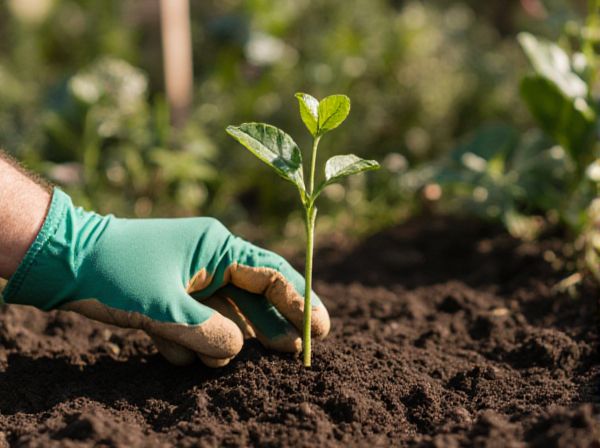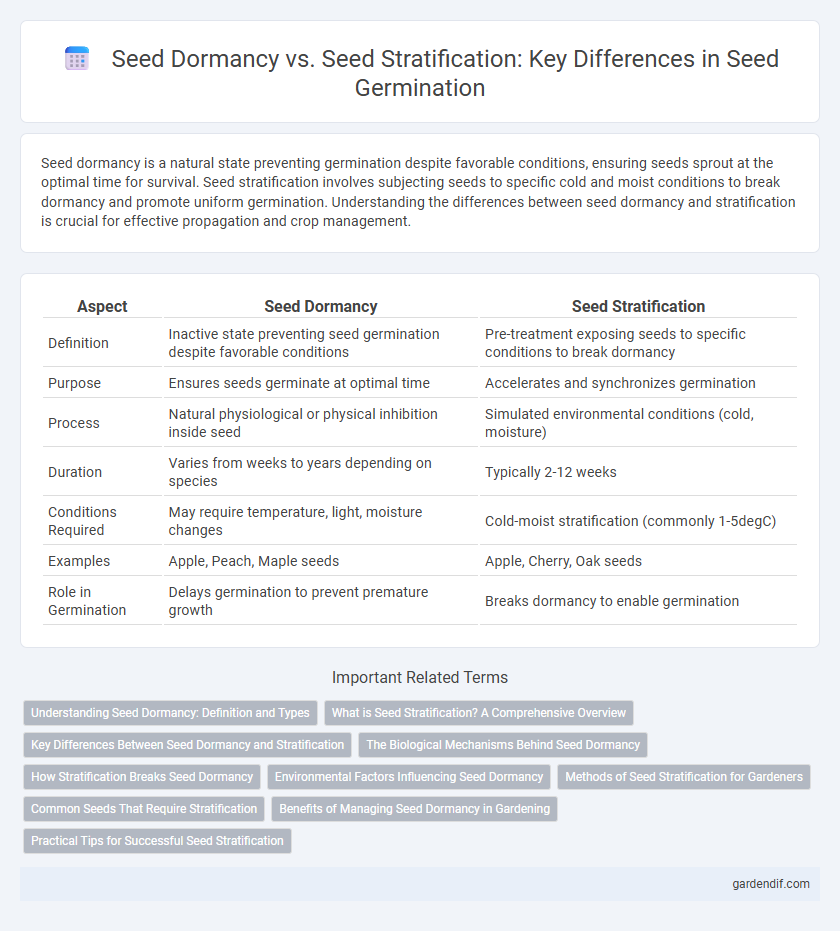
Seed dormancy vs Seed stratification Illustration
Seed dormancy is a natural state preventing germination despite favorable conditions, ensuring seeds sprout at the optimal time for survival. Seed stratification involves subjecting seeds to specific cold and moist conditions to break dormancy and promote uniform germination. Understanding the differences between seed dormancy and stratification is crucial for effective propagation and crop management.
Table of Comparison
| Aspect | Seed Dormancy | Seed Stratification |
|---|---|---|
| Definition | Inactive state preventing seed germination despite favorable conditions | Pre-treatment exposing seeds to specific conditions to break dormancy |
| Purpose | Ensures seeds germinate at optimal time | Accelerates and synchronizes germination |
| Process | Natural physiological or physical inhibition inside seed | Simulated environmental conditions (cold, moisture) |
| Duration | Varies from weeks to years depending on species | Typically 2-12 weeks |
| Conditions Required | May require temperature, light, moisture changes | Cold-moist stratification (commonly 1-5degC) |
| Examples | Apple, Peach, Maple seeds | Apple, Cherry, Oak seeds |
| Role in Germination | Delays germination to prevent premature growth | Breaks dormancy to enable germination |
Understanding Seed Dormancy: Definition and Types
Seed dormancy is a natural survival mechanism that prevents seeds from germinating under unfavorable environmental conditions, ensuring species propagation. Types of seed dormancy include physical dormancy, caused by hard seed coats impervious to water or gases, and physiological dormancy, involving internal chemical inhibitors that delay embryo growth. Understanding these dormancy types is crucial for optimizing seed stratification techniques, such as cold or warm treatment, which break dormancy and promote uniform germination in agriculture and horticulture.
What is Seed Stratification? A Comprehensive Overview
Seed stratification is a pre-germination treatment that mimics natural winter conditions to break seed dormancy and promote germination. This process involves exposing seeds to cold and moist environments, typically between 1 to 5degC for a specified period, which helps disrupt physiological inhibitors preventing seed growth. Effective stratification improves germination rates and uniformity, especially in species with innate dormancy such as apple, cherry, and maple seeds.
Key Differences Between Seed Dormancy and Stratification
Seed dormancy is a natural mechanism that prevents germination under unfavorable conditions by maintaining seeds in a quiescent state. Seed stratification involves exposing seeds to specific environmental treatments, often cold and moist conditions, to break dormancy and promote germination. The key difference lies in dormancy as an inherent survival strategy, whereas stratification is a controlled process used to overcome dormancy and stimulate seed sprouting.
The Biological Mechanisms Behind Seed Dormancy
Seed dormancy is regulated by complex biological mechanisms involving hormonal balances, primarily abscisic acid that inhibits germination, and gibberellins that promote it. The seed coat's impermeability and embryonic physiological state contribute to dormancy by preventing water uptake and metabolic activation. Stratification mimics natural environmental conditions, such as cold temperatures, which break dormancy by altering hormone levels and gene expression, enabling germination to proceed.
How Stratification Breaks Seed Dormancy
Seed dormancy prevents germination until conditions are favorable, often requiring specific environmental cues. Seed stratification breaks dormancy by exposing seeds to controlled cold and moisture, mimicking natural winter conditions to trigger physiological changes. This process alters hormonal balances, particularly reducing abscisic acid and increasing gibberellins, enabling seed germination.
Environmental Factors Influencing Seed Dormancy
Seed dormancy is primarily influenced by environmental factors such as temperature fluctuations, moisture availability, and light exposure, which regulate the physiological state preventing germination. Stratification mimics natural cold and moist conditions, breaking seed dormancy by triggering metabolic changes necessary for embryo development. Soil temperature cycles and seasonal chilling periods are crucial for overcoming dormancy in many temperate species, ensuring germination occurs under favorable environmental conditions.
Methods of Seed Stratification for Gardeners
Seed stratification involves exposing seeds to specific environmental conditions to break dormancy and promote germination, primarily through cold or warm treatments. Common methods for gardeners include cold stratification by placing seeds in a moist medium like sand or peat moss within a refrigerator for several weeks, mimicking winter conditions. Warm stratification entails keeping seeds in a warm, moist environment for a certain period, simulating the natural cycle seeds undergo before germination.
Common Seeds That Require Stratification
Common seeds that require stratification include apple, cherry, peach, and pear, which need a cold, moist treatment to overcome dormancy and trigger germination. Stratification mimics natural winter conditions, breaking seed dormancy by softening the seed coat and activating metabolic processes essential for sprouting. Understanding the stratification requirements of seeds like lilac, echinacea, and clematis improves germination rates and ensures healthy seedling development.
Benefits of Managing Seed Dormancy in Gardening
Managing seed dormancy enhances germination rates by synchronizing seed sprouting with optimal environmental conditions, increasing plant survival and growth. Seed stratification breaks dormancy through controlled temperature and moisture treatments, ensuring uniform and timely seedling emergence. Properly managing dormancy boosts garden productivity by promoting robust plant development and reducing wasted seeds.
Practical Tips for Successful Seed Stratification
Successful seed stratification requires mimicking natural cold and moist conditions to break seed dormancy effectively, typically by placing seeds in a damp medium like peat moss or sand inside a sealed bag and refrigerating them between 1-5degC for a specific period, often 4 to 12 weeks. Monitoring moisture levels is crucial to prevent mold growth while ensuring seeds remain hydrated. Labeling seed types and stratification durations accurately enhances germination success for diverse species with varying dormancy requirements.
Seed dormancy vs Seed stratification Infographic

 gardendif.com
gardendif.com